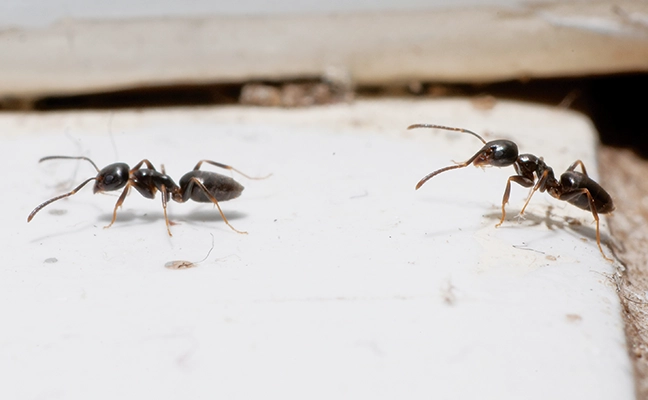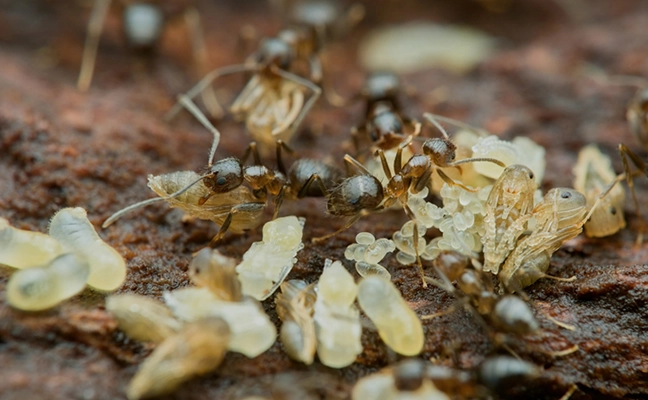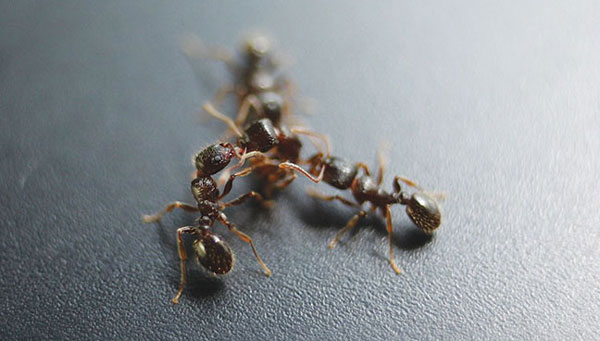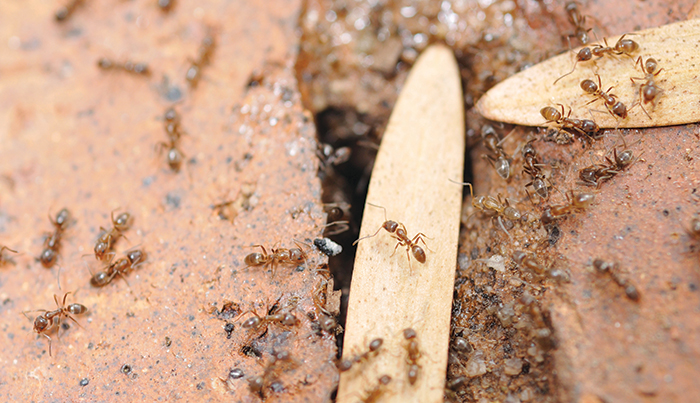Pest management professionals (PMPs) never know what they will encounter when a call comes in for ant control. Here, four pros explain how they managed particularly challenging infestations.
Odorous house ants (Tapinoma sessile, or OHA)

An older customer living in a home built in the late 1800s told me ants had been in the crawlspace for “more than five or six years.” When I first inspected, ants were present throughout the home, including in the basement and the crawlspace, which looked like it was moving. The customer had been spraying do-it-yourself (DIY) products almost every day, sometimes multiple times per day, for a few years. I explained that overapplying was more detrimental than helpful and that a targeted approach would allow ants to be eradicated at their nesting sites.
On my first visit, I used gel bait and granular insecticide. I traced the OHA to a garden shed; they were nesting in several bags of potting soil. The customer agreed to let me add granular insecticide to each of the eight bags of soil.
On my second visit a month later, I saw no activity in the potting soil and just a few straggler ants in the kitchen and crawlspace. I treated the exterior with a termiticide approved for ants.
At each visit thereafter, only a few ants were trailing into the house. I continue to treat with granular and gel. The infestation is 99 percent better.
This customer agreed to professional pest management because her neighbors, who are also my clients, told her they had a great service provider. The neighbors paid for my new client’s first service to prove a point about qualified pest management.
– Melisa Arnold, ACE, owner of Horizon Pest Solutions in New Cambria, Kan.
Caribbean crazy ants (Nylanderia pubens)

An infestation of Caribbean crazy ants was so severe that the clients could no longer live in their home. Piles and piles of dead ants were in the bedrooms, bathrooms, kitchen and living room. They were in every corner of the house, including on the exterior.
I reached out to entomologists at the University of Florida’s Pest Management University. Dr. Faith Oi and her team helped me with a treatment plan that significantly reduced the ant population.
The property was roughly 1 acre. The first month, we treated the lawn with imidacloprid. We used granular bait on the following month’s visit. For the third month, we used gel bait mixed with a gallon of water and one cup of sugar, which helped the ants take the bait because they preferred liquids.
We used this treatment for another two months. It was important to start treatment in February to help get ahead of the infestation, as the ants would start multiplying as the weather got warmer.
While we never achieved 100 percent control, we were able to reduce the population drastically. The clients were satisfied with the results.
– Jacob Morehouse, director of pest prevention for Honor Services in Melbourne, Fla.
Pavement ants (Tetramorium spp.)

A significant pavement ant infestation occurred at a residential barn on a concrete slab that had been converted to a mother-in-law suite. The barn had T1-11 exterior panel siding.
After inspecting the property, we treated areas with active colonies. We sprayed the exterior areas where activity was present and applied a preventive treatment to the rest of the exterior. We sprayed through the floor opening where a metal support beam entered the concrete, baited under the sink area and behind the stove, and sprayed along the header of the old garage door where we detected activity.
We also baited to reduce the carpenter ant (Camponotus spp.) infestation on the second floor. We tried to access the wall cavity for direct treatment, but the walls were filled with spray foam insulation. The carpenter ants made a colony in the spray foam. Spray foam insulation provides carpenter ants with an easily workable medium, as well as coverage from the elements and predators. They flourish in this environment. We typically recommend a multi-product treatment that includes spraying the interior and exterior of the structure, using a non-toxic ant granular application around the exterior foundation and a liquid bait in areas with significant activity levels. We also consider power dusting into wall voids for carpenter ants in traditional batt insulation applications, but with spray foam insulating applications, it is almost futile.
– Michael Listopad, owner, AAA Pest Pros, West Middlesex, Pa.
Argentine ants (Linepithema humile)

For nearly a year, a homeowner had been battling persistent ant activity on her kitchen counter every single day. Frustrated, she made it clear that she would no longer tolerate the infestation and demanded a permanent solution, not a recurring treatment plan that required ongoing maintenance. We implemented a targeted integrated pest management (IPM) strategy designed for rapid and lasting results.
The first critical step was addressing environmental factors that were sustaining the ant population.
Massive redwood trees surrounded the home, and fallen leaves had accumulated along the exterior walls of the kitchen, providing harborage and protection for the ants.
To eliminate this conducive condition, we subcontracted a landscape company to clear all debris, cutting off a key nesting site right against the foundation. We work very well together, and we only bring them in for larger projects. The competitive rate for their services is included in our estimate, along with a detailed breakdown of services and full disclosure of any project management fees associated with it, as transparency is key.
Next, we sealed all kitchen entry points, including windows, counters and baseboards, to block access routes into the home. At the same time, we conducted a deep cleaning behind and underneath the stove, where accumulated grease and food debris had been attracting ants.
With the environment addressed, the third phase involved precise chemical applications tailored to the infestation. We applied liquid treatments at key access points to establish an effective barrier. We used dust in voids and cracks to eliminate hidden colonies. We placed granular baits in high-traffic areas to disrupt foraging activity.
The entire process required three visits over the course of one month. At the final follow-up, the homeowner reported she had not seen a single ant in her home. Legend has it the infestation never returned!
By combining habitat modification, exclusion techniques and targeted treatments, we delivered not just a temporary fix but a long-term, sustainable resolution to the client’s ant problem.
– Sophia Rodriguez, CEO, Sophie’s Pest Solutions, Oakland, Calif.
<p>The post Pest management professionals share advice on managing challenging ant infestations first appeared on Pest Management Professional.</p>
from Pest Management Professional https://www.mypmp.net/pest-management-professionals-share-advice-on-managing-challenging-ant-infestations/
Sacramento CA
No comments:
Post a Comment